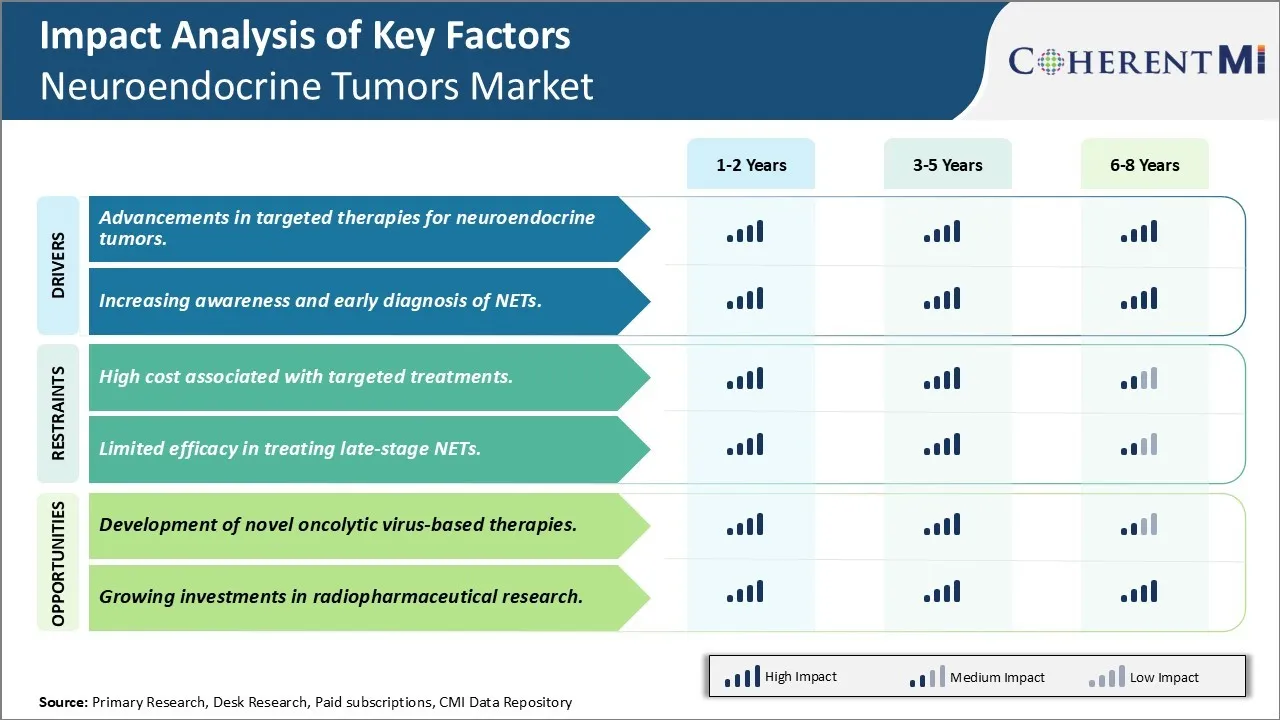Neuroendocrine Tumors Market Trends
Market Driver - Advancements in Targeted Therapies for Neuroendocrine Tumors.
With continuous advancements being made in understanding the biology and pathogenesis of neuroendocrine tumors, targeted therapies have shown promising results. Several molecular targets have been identified in recent years that are dysregulated in NETs. Drugs targeting these molecular alterations have demonstrated clinical benefit with more tolerable safety profiles compared to conventional chemotherapy. Somatostatin analogues like octreotide and lanreotide have established roles in controlling symptoms from functional NETs and limiting tumor growth. Newer somatostatin receptor ligands with more favorable pharmacokinetics are now available which can potentially improve patient outcomes. Drugs targeting tyrosine kinase receptors involved in tumor growth pathways have also shown to provide benefits. Sunitinib and everolimus have been approved for treatment of pancreatic NETs based on large clinical trials demonstrating improved progression-free survival. Everolimus is additionally approved for treatment of non-functional gastrointestinal and lung NETs. Other targeted drugs inhibiting key signaling molecules continue to be investigated in ongoing clinical trials. Combining different targeted agents or combining them with chemotherapy also holds promise. With a deeper mechanistic understanding of disease drivers and improvements in drug development techniques, the availability of effective targeted therapies tailored to the molecular alterations in individual tumors is likely to expand significantly. This will lead to more treatment options associated with better tolerability and quality of life for NET patients.
Market Driver - Increasing Awareness and Early Diagnosis Results in a Huge Demand for Diagnosis.
Diagnosing neuroendocrine tumors at an early stage when the disease is localized can substantially improve treatment effectiveness and prognosis. However, due to the non-specific nature of symptoms associated with NETs and lack of screening recommendations, many patients are often diagnosed at a late stage when the tumor has already metastasized. This poses challenges for management and reduces treatment success rate. Initiatives aimed at educating both patients and healthcare providers about the signs and symptoms of NETs have helped enhance awareness in recent times. Heightened awareness is enabling individuals to recognize potential symptom patterns and seek medical help promptly. It is also making more physicians knowledgeable to include NETs in their differential diagnoses. Additionally, advancements in diagnostic imaging techniques and identification of circulating biomarkers have augmented early detection ability. When combined with a high index of clinical suspicion, these diagnostic tools are facilitating identification of small tumors or detection of metastasis earlier than before in asymptomatic patients. Educating at-risk populations and implementing standardized screening protocols can potentially increase early case finding further. As diagnosis at early stages becomes more common owing to amplified awareness and diagnostic accuracy, it will likely improve survival statistics and treatment outcomes for NET patients in the coming years.

Market Challenge - High Cost Associated with Targeted Treatments.
The cost of targeted therapies for neuroendocrine tumors poses a significant challenge for the market. Many of the new precision medicines for neuroendocrine tumors require genetic or biomarker testing to identify suitable patients. However, these companion diagnostics add substantial costs to the overall treatment and management of the disease. The targeted drugs themselves also have very high price tags, with some costing over USD 100,000 per year of treatment. This level of spending is simply not feasible for many public and private healthcare systems around the world. The high costs limit access to and reimbursement for these important targeted options. Patients and their families also struggle with the economic burden, as out-of-pocket costs continue to rise each year. Overall healthcare expenditures could escalate sharply if cost containment strategies are not adopted. Pharmaceutical companies will need to pursue value-based pricing models and explore partnerships with healthcare payers to make precision medicines for neuroendocrine tumors more affordable and sustainable over the long run.
Market Opportunity: Development of Novel Oncolytic Virus-based Therapies.
The development of oncolytic virus therapies presents a significant opportunity for advancement in the neuroendocrine tumors market. Oncolytic viruses are naturally occurring or bioengineered viruses that can selectively infect and kill cancer cells while avoiding normal tissue. Several types of oncolytic virus are under investigation for the treatment of neuroendocrine tumors, including adenoviruses, herpes viruses, and vaccinia viruses. These novel biotherapies have the potential to help address unmet needs by offering precise cancer cell killing with targeted delivery and minimal side effects. Ongoing clinical research is exploring oncolytic virus therapies both alone and in combination with checkpoint inhibitors or other agents. If successful, oncolytic viruses could transform standards of care by providing new maintenance or consolidation options after initial therapies, as well as treatments for refractory disease. This novel approach holds promise as a next-generation precision medicine for neuroendocrine tumors with a potentially favorable side effect and cost profile compared to traditional options.